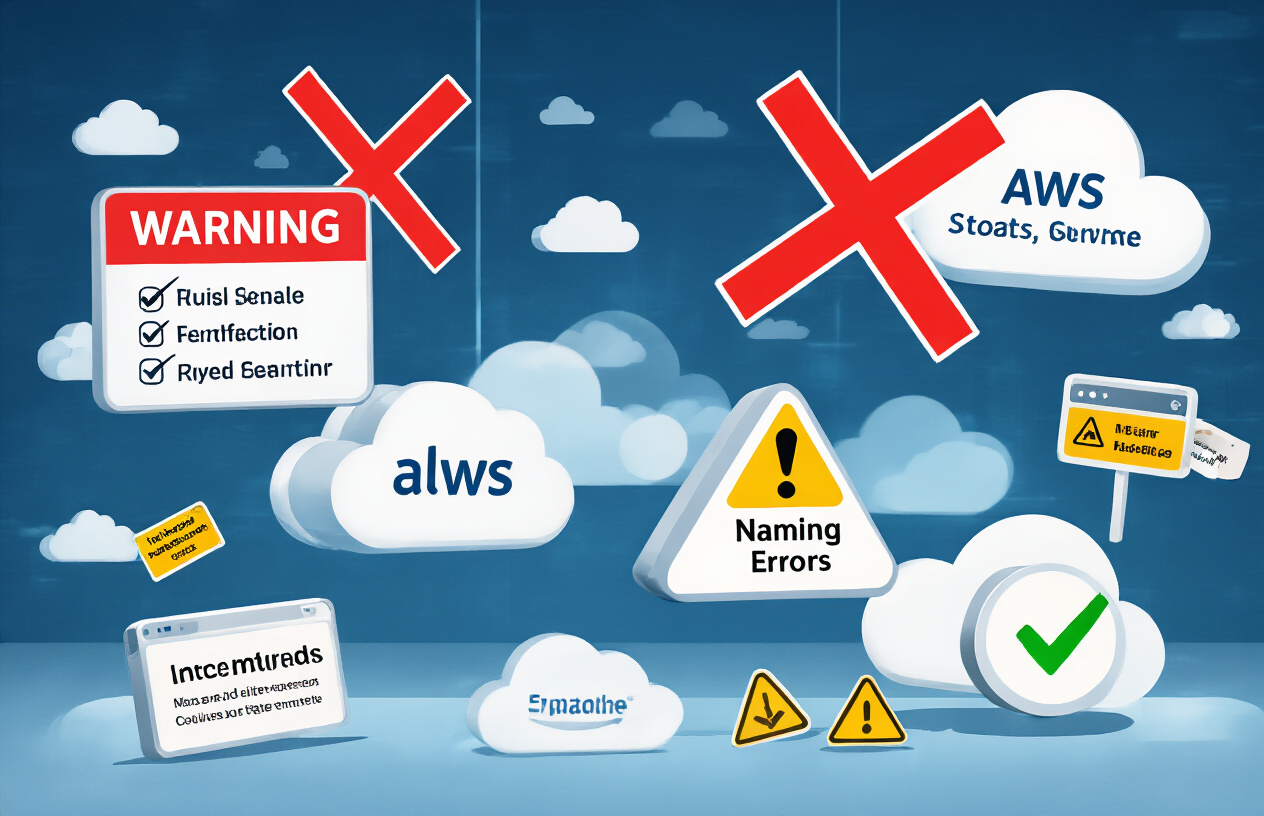Inconsistent AWS naming conventions can turn your cloud infrastructure into a chaotic mess that costs your team hours of confusion and thousands in mismanaged resources. This guide targets DevOps engineers, cloud architects, and IT managers who need to establish clear AWS resource naming best practices across their organizations.
We’ll walk through the core principles that make AWS account naming standards actually work in practice, including how to structure names for maximum clarity and searchability. You’ll also discover how to implement AWS tagging strategies that complement your naming system, creating a comprehensive approach to cloud resource organization. Finally, we’ll cover the automation tools that can enforce these standards at scale, so your team doesn’t have to rely on manual processes that inevitably break down.
Why Proper AWS Naming Standards Save Time and Money

Reduce operational overhead through consistent resource identification
When your AWS resources follow consistent AWS naming conventions, your team spends less time hunting for the right resource and more time solving actual problems. Picture this: you’re troubleshooting a production issue at 2 AM, and instead of scrolling through dozens of resources named “test-server-1” or “prod-thing-final,” you immediately spot “prod-web-app-us-east-1-001” and know exactly what you’re dealing with.
Standardized AWS resource naming best practices create a shared language across your organization. New team members can jump in and understand your infrastructure without lengthy explanations. Senior engineers don’t waste time deciphering cryptic resource names left by previous developers. This consistency translates directly into reduced operational costs – your team becomes more efficient, and efficiency saves money.
The time savings compound across every operational task:
- Resource discovery: Find what you need in seconds, not minutes
- Access management: Apply correct permissions faster with predictable naming patterns
- Documentation: Generate automated documentation when names follow logical structures
- Handoffs: Team members can seamlessly take over projects without confusion
Minimize billing confusion and cost allocation errors
AWS billing becomes significantly clearer when your resources follow proper cloud resource naming guidelines. Without consistent names, cost allocation turns into detective work. Finance teams struggle to understand which charges belong to which department, project, or environment.
Proper naming standards eliminate billing mysteries by making every resource’s purpose and ownership crystal clear. When your S3 bucket is named “marketing-website-assets-prod” instead of “bucket-123-final,” your accounting team knows exactly where to allocate those storage costs.
Consider these common billing scenarios where naming standards prevent costly errors:
| Scenario | Without Standards | With Standards |
|---|---|---|
| Department billing | Guesswork and disputes | Clear cost allocation |
| Project tracking | Manual resource mapping | Automated cost reports |
| Environment separation | Mixed dev/prod costs | Accurate environment billing |
| Resource ownership | Orphaned resources continue charging | Clear ownership prevents waste |
Cost allocation errors don’t just create accounting headaches – they lead to poor business decisions. Teams might cut budgets for efficiently-run projects while overfunding wasteful ones, simply because the billing data is too messy to interpret correctly.
Accelerate troubleshooting and incident response
During critical incidents, every second counts. AWS infrastructure naming standards can mean the difference between a five-minute fix and a two-hour debugging marathon. When resources follow predictable patterns, your monitoring tools, runbooks, and team knowledge all align perfectly.
Imagine your monitoring alert shows high CPU usage on “prod-api-gateway-us-west-2-002.” Your team immediately knows they’re looking at the second API gateway instance in the US West 2 region for the production API service. No guessing, no confusion, no time wasted.
Effective naming accelerates incident response in several ways:
- Faster identification: Pinpoint affected resources without cross-referencing documentation
- Clearer communication: Teams use consistent terminology during incident calls
- Automated responses: Scripts and automation tools work reliably with predictable names
- Reduced errors: Less chance of accidentally modifying the wrong resource during high-stress situations
Your incident response procedures become more reliable when they can depend on consistent AWS resource management best practices. Runbooks work across
Core Principles for AWS Account Naming

Establish hierarchical naming for multi-account organizations
AWS account naming conventions become critical when you’re managing multiple accounts across different teams, environments, and projects. A solid hierarchical approach creates a logical structure that everyone can understand at a glance.
Start with your organization’s top-level structure. If you’re running separate business units like marketing, engineering, and finance, incorporate these into your account names. A typical hierarchy might look like company-businessunit-environment-purpose. For example: acme-engineering-prod-web or acme-marketing-dev-analytics.
The key is consistency across your entire organization. When team members see an account name, they should immediately understand which part of the business it serves and what role it plays in your infrastructure. This prevents confusion when someone needs to access resources or troubleshoot issues across multiple accounts.
Consider your future growth too. Your naming structure should accommodate new business units, projects, or environments without breaking the existing pattern. Many organizations make the mistake of creating ad-hoc names that seem logical at the time but don’t scale well.
Include environment indicators in account names
Environment indicators serve as immediate visual cues that help prevent costly mistakes. Nothing ruins your day quite like accidentally deploying test code to production because you couldn’t quickly identify which environment you were working in.
Common environment indicators include:
prodorproductionfor live systemsstagingorstagefor pre-production testingdevordevelopmentfor active development worktestfor automated testing environmentssandboxfor experimental or learning environments
Place environment indicators consistently within your naming structure. Most teams put them after the business unit identifier: company-unit-env-purpose. This creates a predictable pattern where the environment is always in the same position.
Color-coding or additional visual cues in your AWS console can complement these naming conventions, but the account name itself should be clear enough that anyone can identify the environment without additional context.
Incorporate business unit or project identifiers
Business unit and project identifiers create clear ownership boundaries and help with cost allocation. When your AWS bill arrives, you want to see exactly which teams or projects are consuming resources.
For business units, use abbreviated but recognizable names. Instead of human-resources, consider hr. Instead of customer-support, use support. Keep abbreviations consistent and document them so new team members understand the system.
Project identifiers work well for temporary or specific initiatives. You might have acme-eng-prod-mobile-app for your mobile application project or acme-marketing-dev-campaign-2024 for a specific marketing campaign’s development environment.
| Naming Component | Example | Purpose |
|---|---|---|
| Company | acme | Brand consistency |
| Business Unit | eng, marketing, finance | Ownership clarity |
| Environment | prod, dev, test | Risk management |
| Project/Purpose | web, api, analytics | Resource identification |
Remember that AWS account names have character limits and restrictions. Stick to lowercase letters, numbers, and hyphens. Avoid underscores or special characters that might cause issues with automation tools or integrations down the line.
The goal is creating AWS account naming standards that work for both humans and machines, making your cloud infrastructure more manageable and reducing the risk of expensive mistakes.
Essential Resource Naming Components

Standardize prefixes and suffixes across all resources
Creating consistent prefixes and suffixes forms the backbone of effective AWS naming conventions. Think of prefixes as the first name that immediately tells you what type of resource you’re looking at, while suffixes provide additional context like purpose or sequence numbers.
Common prefix patterns include using your organization abbreviation (like “acme” for ACME Corporation) followed by the service type. For example, “acme-web-” for web servers or “acme-db-” for databases. This approach makes resource identification instant when scanning through hundreds of resources in the AWS console.
Suffixes work best when they indicate function or sequence. Adding “-prod,” “-dev,” or “-staging” as suffixes clearly separates environments, while numerical suffixes like “-001,” “-002” help track multiple instances of similar resources. Some teams prefer descriptive suffixes like “-primary” and “-backup” for database instances.
The key is picking a pattern and sticking to it religiously across your entire AWS infrastructure. Mixed approaches create confusion and defeat the purpose of standardization.
Define consistent abbreviations for AWS services
AWS service abbreviations prevent resource names from becoming unwieldy while maintaining clarity. Since AWS has over 200 services, creating a standardized abbreviation dictionary saves characters and improves readability across your cloud infrastructure.
| AWS Service | Standard Abbreviation | Example Usage |
|---|---|---|
| EC2 Instance | ec2 | acme-ec2-web-prod-001 |
| RDS Database | rds | acme-rds-mysql-dev-001 |
| S3 Bucket | s3 | acme-s3-backups-us-east-1 |
| Lambda Function | lambda | acme-lambda-processor-prod |
| Application Load Balancer | alb | acme-alb-web-prod-001 |
| Elastic File System | efs | acme-efs-shared-prod-001 |
Keep abbreviations intuitive and avoid overly cryptic shortcuts. “rds” makes sense for Amazon RDS, but “rel-db-svc” doesn’t add value and wastes characters. Document your abbreviation standards in a shared location where all team members can reference them.
Consider regional variations too. Some teams include service abbreviations that reflect specific configurations, like “rds-mysql” versus “rds-postgres” to distinguish database engines at the name level.
Include environment and region identifiers
Environment and region identifiers prevent costly mistakes like accidentally modifying production resources when you meant to work in development. These identifiers should be immediately visible in resource names to provide instant context about where and what you’re working with.
Environment naming works best with short, clear identifiers:
- “prod” for production
- “dev” for development
- “staging” for staging/pre-production
- “test” for testing environments
- “sandbox” for experimental work
Region identifiers help especially when managing multi-region deployments. Use AWS region codes like “us-east-1” or “eu-west-1” directly, or create shortened versions like “use1” or “euw1” if character limits are tight.
Position these identifiers consistently within your naming pattern. Many successful implementations use: [company]-[service]-[application]-[environment]-[region]-[sequence]. This creates names like “acme-ec2-web-prod-use1-001” that immediately communicate every essential detail.
Multi-region disaster recovery setups benefit enormously from region identifiers. When spinning up emergency resources in a different region, clear naming prevents confusion about which resources belong where.
Add version or iteration numbers for iterative resources
Version numbers and iteration identifiers track resource evolution and enable safe rollback strategies. This becomes critical when deploying infrastructure changes or managing multiple generations of similar resources.
Sequential numbering with zero-padding works well for most scenarios. Use “001,” “002,” “003” rather than “1,” “2,” “3” to maintain proper sorting in AWS consoles and CLI outputs. This prevents the common issue where “10” appears before “2” in alphabetical listings.
Version naming strategies depend on your deployment approach:
- Blue-green deployments: Use color codes like “acme-ec2-web-prod-blue-001” and “acme-ec2-web-prod-green-001”
- Rolling updates: Increment sequence numbers like “acme-lambda-processor-v003”
- Feature branches: Include branch identifiers like “acme-rds-feature-auth-001”
Date-based versioning works for resources tied to specific releases. Names like “acme-s3-deployment-20240315-001” immediately show when resources were created, making cleanup and auditing straightforward.
Consider your resource lifecycle when choosing version patterns. Short-lived resources might use timestamps, while long-term infrastructure benefits from semantic versioning or simple sequential numbering that survives multiple updates and modifications.
Service-Specific Naming Guidelines

EC2 Instances and Security Groups Naming Patterns
EC2 instances need clear, descriptive names that immediately tell you their purpose and environment. A solid pattern includes environment, application, function, and instance number: prod-webapp-frontend-001 or dev-database-mysql-002. This approach makes it easy to spot production resources at a glance and prevents accidental modifications.
Security groups should mirror the resources they protect. Use patterns like sg-prod-webapp-frontend or sg-dev-database-mysql to create obvious connections between groups and their protected instances. Include port information when specific: sg-prod-webapp-https-443 gives immediate context about the traffic allowed.
For auto-scaling groups, incorporate the scaling behavior: asg-prod-webapp-frontend-min2-max10 provides essential information about capacity limits. Launch templates should match their target instances: lt-prod-webapp-frontend-v2 clearly indicates version and purpose.
S3 Bucket Naming Requirements and Recommendations
S3 bucket names must be globally unique and follow strict AWS naming conventions. They can only contain lowercase letters, numbers, and hyphens, with no spaces or special characters. Names must be between 3-63 characters and cannot start or end with hyphens.
Smart bucket naming includes organization, environment, purpose, and region: mycompany-prod-webapp-logs-us-east-1 or acmecorp-dev-data-backup-eu-west-1. This pattern prevents naming conflicts while providing clear context about bucket contents and location.
Avoid using periods in bucket names as they can cause SSL certificate validation issues. Also, don’t include sensitive information like account numbers or internal project codenames that might expose organizational structure.
Consider bucket lifecycle and access patterns in your naming. Archival buckets might include retention periods: mycompany-prod-archive-7year-us-east-1. Data lake buckets can indicate processing stages: datacompany-prod-raw-customer-data versus datacompany-prod-processed-customer-data.
Lambda Function and API Gateway Naming Conventions
Lambda functions work best with descriptive names that include the trigger source and action: api-user-registration, s3-image-processor, or sns-email-notification. This immediately tells you how the function gets invoked and what it does.
Environment prefixes help separate development from production: prod-api-user-registration or dev-s3-image-processor. Version numbers in function names can track major changes: prod-payment-processor-v2 indicates a significant update from the original version.
API Gateway naming should reflect the service architecture. REST APIs might use: prod-user-service-api or dev-inventory-management-api. Stage names should be simple and consistent: prod, staging, dev rather than creative names that confuse team members.
Resource paths within APIs should follow RESTful conventions: /users/{id}, /orders/{orderId}/items. Method naming for Lambda integrations should match the HTTP verb and resource: get-user-by-id or create-order-item.
Database and Storage Service Naming Standards
RDS instances need names that specify the database type, environment, and purpose: prod-mysql-userdata or dev-postgres-analytics. Include version numbers for major database versions: prod-mysql8-inventory helps track which systems need upgrades.
Database snapshots should include timestamp and source information: prod-mysql-userdata-20241101-daily or pre-upgrade-prod-postgres-analytics-20241101. This makes restoration decisions much easier during incident response.
DynamoDB tables benefit from descriptive names that indicate data structure: prod-user-sessions, dev-product-inventory, or analytics-clickstream-events. Include the access pattern in the name when relevant: user-data-by-email suggests the primary key structure.
ElastiCache clusters should indicate caching purpose: prod-session-cache or dev-query-results-cache. Redis clusters might include data type information: prod-user-counters-redis or staging-leaderboard-cache.
Network Resource Naming for VPCs and Subnets
VPC naming should immediately identify the environment and purpose: prod-main-vpc, dev-testing-vpc, or staging-webapp-vpc. Include region information when managing multi-region deployments: prod-main-vpc-us-east-1.
Subnet names need to convey their availability zone and function: prod-public-1a, prod-private-1b, or prod-database-1c. This pattern makes it obvious which subnets can host internet-facing resources and provides AZ information for high availability planning.
Route tables should match their associated subnets: rt-prod-public for public subnet routing or rt-prod-private-1a for zone-specific private routing. Internet gateways and NAT gateways follow similar patterns: igw-prod-main and nat-prod-1a.
Security groups at the network level need clear descriptions of their traffic rules: sg-prod-web-public-http, sg-prod-database-private, or sg-prod-internal-services. The name should immediately tell you what traffic flows through these groups and from where.
Network ACLs benefit from descriptive names that indicate their restrictive nature: nacl-prod-public-web or nacl-prod-private-secure. Since NACLs are stateless and often more restrictive than security groups, clear naming prevents configuration mistakes that could block legitimate traffic.
Implementing Tagging Strategies Alongside Names

Create mandatory tags that complement naming conventions
AWS tagging strategies work hand-in-hand with your naming conventions to create a comprehensive resource management system. Mandatory tags fill the gaps that naming alone cannot address, providing additional context and searchability for your cloud infrastructure.
Start by establishing core mandatory tags that every AWS resource must have. The most critical ones include Name, Owner, Environment, Project, and CostCenter. These tags should be required at resource creation time through AWS Organizations Service Control Policies or CloudFormation templates.
Your Name tag should mirror your naming convention structure but can include additional descriptive text. For example, while your EC2 instance name might be prod-web-app-01, the Name tag could expand to Production Web Application Server 01. This approach gives you both programmatic consistency and human-readable descriptions.
Consider implementing tag hierarchies that complement your naming standards. If your naming convention uses environment prefixes like dev-, staging-, and prod-, create corresponding Environment tags with values like Development, Staging, and Production. This redundancy helps with both automation and reporting.
Establish cost center and ownership tagging requirements
Cost management becomes significantly easier when you implement consistent cost center and ownership tagging alongside your AWS naming conventions. These tags enable accurate cost allocation, chargeback processes, and accountability across your organization.
Define ownership tags at multiple levels to create clear responsibility chains. The Owner tag should contain the individual responsible for the resource, while Team or Department tags identify the broader organizational unit. Add contact information through tags like OwnerEmail to ensure someone can always be reached about resource-related issues.
Cost center tagging requires coordination with your finance team to establish valid cost center codes. Create a centralized list of approved values and implement validation through AWS Config rules or custom Lambda functions. Common cost center tag patterns include:
| Tag Key | Example Values | Purpose |
|---|---|---|
CostCenter |
CC-12345, CC-67890 | Financial allocation |
BillingGroup |
Engineering, Marketing, Sales | High-level cost grouping |
Budget |
Q1-2024-WebApp, Annual-Infrastructure | Budget tracking |
Define environment and lifecycle tags
Environment and lifecycle tags provide essential context for resource management, automated operations, and compliance requirements. These tags should align with your naming conventions while offering additional operational intelligence.
Environment tags go beyond simple dev/staging/prod classifications. Consider granular environment types like sandbox, integration, performance-testing, pre-production, and production. This detailed categorization helps teams understand resource purposes and appropriate handling procedures.
Lifecycle tags track resource states and automated management requirements. Key lifecycle tags include:
Lifecycle: Values likepermanent,temporary,experimentalBackup: Requirements such asdaily,weekly,noneMonitoring: Levels likecritical,standard,minimalAutoShutdown: Schedules such asnights-weekends,never,custom
Create automation workflows that respond to these lifecycle tags. Resources tagged with AutoShutdown: nights-weekends can be automatically stopped outside business hours, while Backup: daily triggers appropriate backup policies.
Implement validation rules to ensure tag consistency across your AWS infrastructure. Use AWS Config to monitor tag compliance and automatically remediate missing or incorrect tags. This approach maintains data quality and supports reliable automated operations based on your tagging strategy.
Automation Tools for Enforcing Naming Standards

Use AWS Config rules to validate naming compliance
AWS Config rules provide an automated way to monitor and enforce your AWS naming conventions across your entire infrastructure. You can create custom rules that evaluate resource names against your established patterns and automatically flag non-compliant resources. These rules run continuously, checking both new resources as they’re created and existing resources when changes occur.
Setting up Config rules for naming validation involves defining the specific naming patterns you want to enforce. For example, you can create rules that verify EC2 instances follow the pattern env-application-role-sequence or that S3 buckets include the mandatory company prefix. The rules can check for required elements, character restrictions, and even validate that names align with your tagging strategies.
When a resource fails naming validation, AWS Config generates compliance notifications and can trigger automated remediation workflows. This real-time feedback helps development teams catch naming issues before they become widespread problems. The compliance dashboard gives you a centralized view of naming standard adherence across all accounts and regions.
Implement Service Control Policies for naming enforcement
Service Control Policies (SCPs) in AWS Organizations act as guardrails that prevent the creation of improperly named resources at the source. Unlike Config rules that detect issues after resources are created, SCPs block non-compliant resource creation entirely. This proactive approach saves cleanup time and prevents naming inconsistencies from entering your environment.
Creating effective SCPs for naming requires careful planning. You’ll define JSON policies that use condition statements to evaluate resource names during creation attempts. For instance, you can create policies that deny EC2 instance creation unless the name matches specific patterns or contains required organizational identifiers.
The beauty of SCPs lies in their hierarchical nature. You can apply different naming requirements at the organizational unit level, allowing for variations between development, staging, and production environments while maintaining core naming principles. These policies automatically inherit down the organizational tree, ensuring consistent enforcement across all child accounts.
Leverage Infrastructure as Code templates with naming validation
Infrastructure as Code (IaC) templates offer the perfect opportunity to embed naming validation directly into your deployment processes. Whether using AWS CloudFormation, Terraform, or AWS CDK, you can build naming logic into your templates that automatically generates compliant names and validates custom inputs.
CloudFormation templates can include parameter validation patterns that reject stack deployments with non-compliant naming inputs. You can create reusable naming functions that combine environment variables, application identifiers, and resource types into standardized names. This approach ensures every resource deployed through your templates follows your naming conventions automatically.
Terraform modules can include variable validation blocks that check naming patterns before resource creation. The validation happens during the planning phase, catching naming issues before any AWS resources are actually created. This early feedback loop helps developers understand naming requirements and adjust their configurations accordingly.
Set up monitoring alerts for non-compliant resources
Monitoring alerts create the feedback loop necessary to maintain naming standards over time. AWS CloudWatch Events can trigger notifications whenever resources are created with non-compliant names, allowing for immediate intervention. These alerts help identify training gaps and process breakdowns that lead to naming violations.
EventBridge rules can monitor CloudTrail logs for resource creation events and evaluate names against your standards. When violations occur, the system can send notifications to team leads, create tickets in your tracking system, or even trigger automated remediation workflows. This real-time monitoring prevents small naming issues from becoming large-scale problems.
Setting up comprehensive monitoring involves creating alerts for different violation types. Some alerts might be informational for minor deviations, while others could be critical for security-sensitive resources with improper names. The alert severity helps teams prioritize remediation efforts and focus on the most important naming compliance issues first.
Common Naming Pitfalls and How to Avoid Them

Prevent naming conflicts across regions and environments
Picture this: you’re deploying your application to production, and suddenly your deployment script fails because there’s already a resource with the same name in another region. This scenario happens more often than you’d think, especially when teams don’t plan for cross-region deployments from the start.
Global resources like S3 buckets create the biggest headaches since bucket names must be globally unique across all AWS accounts and regions. Your seemingly clever bucket name my-company-data might already be taken by another AWS customer. The solution? Include your organization identifier, environment, and region in the name: acme-corp-prod-us-east-1-data-bucket.
For region-specific resources, conflicts arise when you expand to multiple regions or when different teams work in the same account. A Load Balancer named web-lb in us-east-1 will conflict when you try to create another web-lb in us-west-2. Build region codes into your AWS naming conventions: web-lb-use1 and web-lb-usw2.
Environment separation requires careful planning too. Resources named database-cluster will clash when you promote staging configurations to production. Embed environment identifiers: database-cluster-staging and database-cluster-prod. This approach prevents accidental overwrites and makes your infrastructure deployment scripts more reliable across different environments.
Avoid special characters that break automation scripts
Automation scripts are picky about special characters, and what works in the AWS console might crash your Infrastructure as Code templates. Characters like spaces, slashes, and certain symbols can break CloudFormation, Terraform, or custom scripts that manage your resources.
Stick to alphanumeric characters, hyphens, and underscores for maximum compatibility. While AWS allows periods in some resource names, they can cause issues in DNS resolution or when resources are referenced in scripts. For example, a security group named web-sg.production might work in the console but fail when referenced in a bash script or CloudFormation template.
| Avoid These Characters | Use Instead | Why |
|---|---|---|
| Spaces | Hyphens (-) | Spaces break command-line tools |
| Forward slashes (/) | Hyphens (-) | Interpreted as path separators |
| Special symbols (@, #, %) | Letters/numbers | Cause parsing errors in scripts |
| Periods in most cases | Hyphens (-) | DNS and scripting conflicts |
Some AWS services have specific character restrictions that are stricter than others. EC2 instances, for instance, support fewer special characters than S3 bucket names. Design your AWS resource naming best practices around the most restrictive service you’ll use to maintain consistency across your entire infrastructure.
Plan for scalability in your naming structure
Your startup’s simple naming scheme might work fine with five resources, but what happens when you’re managing thousands? Many organizations start with basic names like web-server-1 and web-server-2, only to realize they need a complete restructuring when they scale.
Think about hierarchical naming that can grow with your organization. Instead of flat naming like api-server-prod, consider structured approaches: prod-api-web-001 or web-api-prod-us-east-1-001. This structure accommodates multiple applications, environments, regions, and instance numbers without running into conflicts.
Version control becomes critical as your infrastructure grows. Plan for resource lifecycle management in your names. Rather than reusing names like database-v1, database-v2, consider timestamp-based or semantic versioning: user-db-2024-q1 or user-db-1-2-0. This prevents confusion when rolling back deployments or maintaining multiple versions.
Consider your team’s growth too. What makes sense to your three-person DevOps team today might be incomprehensible to your twenty-person engineering organization next year. Your AWS naming standards implementation should include documentation and training materials that help new team members understand the logic behind your naming decisions. Build naming schemes that are intuitive enough for new engineers to follow without extensive documentation, but structured enough to scale with your organization’s complexity.

Building solid naming standards for your AWS accounts and resources isn’t just about staying organized—it’s about saving your team countless hours and preventing costly mistakes down the road. When you establish clear naming conventions that include environment indicators, project codes, and consistent formatting, you create a system that anyone on your team can understand at a glance. Pairing these naming standards with smart tagging strategies and automation tools takes the guesswork out of resource management and helps you avoid those frustrating moments when you can’t find what you’re looking for in a sea of poorly named resources.
Start implementing these naming practices in your AWS environment today, even if it means updating existing resources gradually. The upfront effort of establishing and enforcing these standards will pay dividends as your infrastructure grows and your team expands. Your future self—and your teammates—will thank you for creating a clean, predictable naming system that makes AWS resource management feel less like detective work and more like the smooth operation it should be.




















